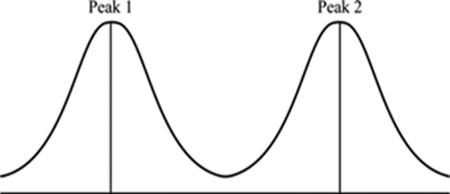
What is a bimodal distribution?
Answer
438.9k+ views
Hint: Data distributions in statistics can have one peak, or they can have several peaks. The type of distribution you might be familiar with seeing is the normal distribution, or bell curve, which has one peak. The bimodal distribution has
Complete step by step solution:
The “bi” in bimodal distribution refers to “
For example, the distribution of heights in a sample of adults might have two peaks, one for women and one for men.
Another example is exam scores which tend to be normally distributed with a single peak. However, grades sometimes fall into a bimodal distribution with a lot of students getting A grades and a lot getting F grades. This can tell you that you are looking at two different groups of students. It could be that one group is underprepared for the class (perhaps because of a lack of previous classes). The other group may have over prepared.
Bimodal distribution showing two normal distribution curves combined, to show peaks in following diagram:

Bimodal distributions are a commonly used example of how summary statistics such as the mean, median, and standard deviation can be deceptive when used on an arbitrary distribution. Application of bimodal distribution to the detection of changes in uranium concentration in drinking water is notable.
Note:
Sometimes, what appears to be a bimodal distribution is actually two unimodal (one-peaked) distributions graphed on the same axis. Multimodal distributions have more than two peaks. Although bimodal (or multimodal) distributions can be revealing of systematic biases or issues, they often occur naturally as well. These naturally bimodal distributed variables include the colour of galaxies, the size of worker weaver ants, the age of incidence of Hodgkin’s lymphoma, traffic analysis, water demand etc.
Complete step by step solution:
The “bi” in bimodal distribution refers to “
For example, the distribution of heights in a sample of adults might have two peaks, one for women and one for men.
Another example is exam scores which tend to be normally distributed with a single peak. However, grades sometimes fall into a bimodal distribution with a lot of students getting A grades and a lot getting F grades. This can tell you that you are looking at two different groups of students. It could be that one group is underprepared for the class (perhaps because of a lack of previous classes). The other group may have over prepared.
Bimodal distribution showing two normal distribution curves combined, to show peaks in following diagram:

Bimodal distributions are a commonly used example of how summary statistics such as the mean, median, and standard deviation can be deceptive when used on an arbitrary distribution. Application of bimodal distribution to the detection of changes in uranium concentration in drinking water is notable.
Note:
Sometimes, what appears to be a bimodal distribution is actually two unimodal (one-peaked) distributions graphed on the same axis. Multimodal distributions have more than two peaks. Although bimodal (or multimodal) distributions can be revealing of systematic biases or issues, they often occur naturally as well. These naturally bimodal distributed variables include the colour of galaxies, the size of worker weaver ants, the age of incidence of Hodgkin’s lymphoma, traffic analysis, water demand etc.
Recently Updated Pages
Master Class 12 Business Studies: Engaging Questions & Answers for Success

Master Class 12 English: Engaging Questions & Answers for Success

Master Class 12 Social Science: Engaging Questions & Answers for Success

Master Class 12 Chemistry: Engaging Questions & Answers for Success

Class 12 Question and Answer - Your Ultimate Solutions Guide

Master Class 11 Economics: Engaging Questions & Answers for Success

Trending doubts
Draw a labelled sketch of the human eye class 12 physics CBSE

a Tabulate the differences in the characteristics of class 12 chemistry CBSE

Which one of the following is a true fish A Jellyfish class 12 biology CBSE

Why is the cell called the structural and functional class 12 biology CBSE

Differentiate between homogeneous and heterogeneous class 12 chemistry CBSE

Write the difference between solid liquid and gas class 12 chemistry CBSE




